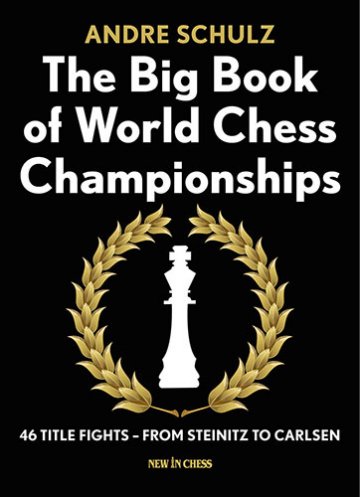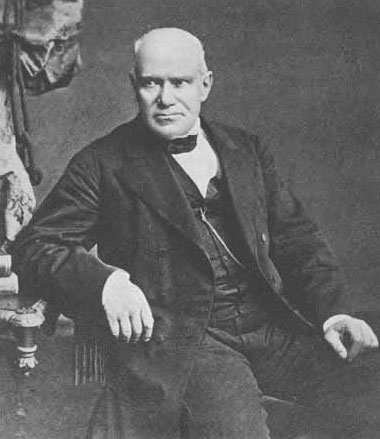
"Chess is so inspiring that I do not believe a good player
is capable of having an evil thought during the game."
Wilhelm Steinitz
Wilhelm Steinitz: A short biography
Wilhelm Steinitz was born on 17th May in Prague into a poor Jewish family as the ninth of 13 children. In his recently published Big Book of World Chess Championships ChessBase editor André Schulz details Steinitz's family background:
"His father was a tailor and a teacher of the Talmud, ... his mother Anna Steinitz, née Torschowa. ... Steinitz' four younger siblings died in childhood, as did two older siblings. Steinitz himself was born with a club foot and all his life required the aid of a crutch. Steinitz was small in stature, no taller than 1.50 metres. ... Steinitz learned chess at the age of 12 from a friend of his father, or according to other sources from a school friend. He is supposed to have carved his first chess pieces himself and used a piece of chequered cloth as a chess board. ...
According to many sources Steinitz is said to have gone in the Jewish school in the ghetto and there have received instruction in Hebrew grammar and in biblical studies. Amongst his ancestors there were some scholars of the Talmud and Steinitz too, according to the wishes of his parents, was to become such a scholar, and attend the 'Yeshiva', the high school for the study of the Talmud. After he refused to give in to these desires, a break with his parents is supposed to have occurred. ...
In 1853 Steinitz got to know Josef Popper, who later became known under the pseudonym Lynkeus as a writer and social reformer, but also as the author of technical treatises. ... With his help, Steinitz caught up in his studies in the 'Lesehalle der deutschen Studenten' (or 'reading room for German students').
In 1858 Steinitz went to Vienna to study Mathematics and worked as a journalist to finance his studies. But "since he could not meet the fees for his studies in this way and was having health problems with his lungs and eyes, Steinitz stopped his studies ut from time to time continued to attend lectures with his friend Popper ... Influenced by these, Steinitz later began to apply scientific principles to chess." (The Big Book of World Chess Championships)

André Schulz, The Big Book of World Chess Championships,
New in Chess 2015, 352 pages, €22,95
In 1860 Steinitz became a chess professional, and in 1862 he moved to London, at that time the centre of the chess world. Steinitz soon established himself as one of the leading players of the time and in 1866 he played a match against Adolf Anderssen, who after Paul Morphy's withdrawal from chess was considered to be the number one in the chess world. Steinitz won he match with a score of 8-6 (no draws).

Adolf Anderssen
However, at the big tournament in Baden-Baden 1870 Steinitz came second behind Anderssen. For Steinitz this was a disappointing result that led him to reassess his own play critically and to change his style. Three years later, in 1873, Steinitz convincingly won the tournament in Vienna and established himself as the world's best player.
After this success Steinitz withdrew from tournament chess for nine years and worked as a chess journalist and theoretician. But in 1876 he played a match against Blackburne which he won 7-0 and between 1873 and 1874 Steinitz took part in a two-game correspondence match between London and Vienna. An important match as Craig Pritchett observed in his book Steinitz: Move by Move (Everyman 2015):
"In his International Chess Magazine (January 1890) Steinitz wrote that 'the systematic analytical development of modern ideas dates from the match between London and Vienna'. Aided by William Potter, his main partner in the London team, Steinitz devoted countless hours of analysis to these two prestigious correspondence games, which the partners ably summed up in many hundreds of words and high quality variations, in their exhaustive game annotations, presented in The Field.
Steinitz's use of the words 'systematic' and 'analytical' reflect his new-found ... zeal for the application of the most rigorous scientific standards to probe the game's truths, which ruled out all appeal to general rules or unsubstantiated principles."
But in 1882 Steinitz played again and took part in the tournament in Vienna, sharing first place with Szymon Winawer. However, one year later, in London 1883 Steinitz finished second, three points behind Johan Hermann Zukertort. This success led Zukertort to claim that he was the best player in the world and after some heated public debates Steinitz and Zukertort finally agreed to the terms of a match that took place in 1886 and was played in three American cities: New York, St. Louis, and New Orleans. According to the Oxford Companion to Chess by Kenneth Whyld and David Hooper "they agreed that the first to win ten games should be declared world champion, but that if each won nine the title would not be awarded". Steinitz won 12.5-7.5 (+10, =5, -5) to become the first official World Chess Champion.
Steinitz later defended his title against Mikhail Chigorin (1889 and 1892) and against Isidor Gunsberg (1890-1891). But in 1894 he lost the title to Emanuel Lasker - after 24 match victories en suite Steinitz's first lost match since 1862. Steinitz also lost the rematch against Lasker that was played in 1896-1897.
During his rematch with Lasker Steinitz was already quite ill and three years later "on the 12th of August he died of heart failure totally impoverished in New York State Asylum on Ward's Island ... . In September he was buried in a pauper's grave. The German Press Club paid for the re-internment in the Evergreen Cemetery in Brooklyn (Bethel Slope, Grave No. 5892). The inscription on his gravestone is in German: 'Hier ruhet in Frieden'." (The Big Book of World Chess Championships)
Three games
At the start of his career Steinitz was fond of wild tactical games and his keen eye for combinations brought him the nickname "the Austrian Morphy". The following game is a typical example for his play at that stage of his career.
But later in his career Steinitz realised the limitations of this kind of wild attacking play and consciously worked on a revision of his style. The following victory against Anderssen reflects this change.
However, the most famous Steinitz game is still a brilliant sacrificial attack with a stunning rook sacrifice - one of the most impressive combinations of all times.
This game was played at the tournament of Hastings 1895, late in Steinitz's career and shows what an amazing player he was.


























